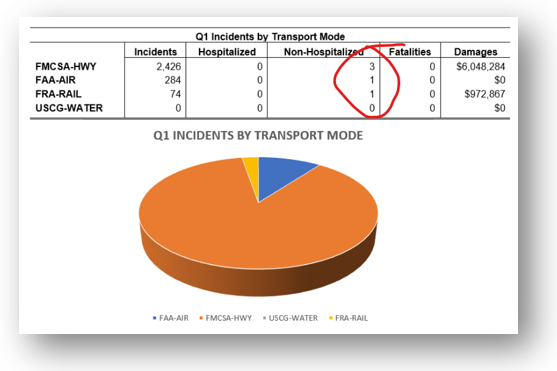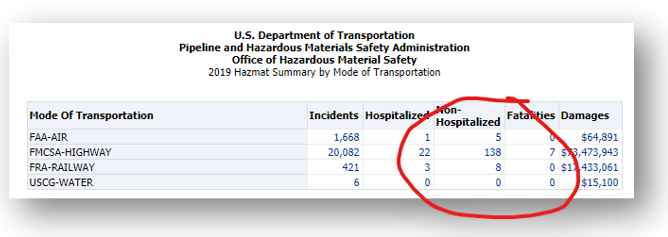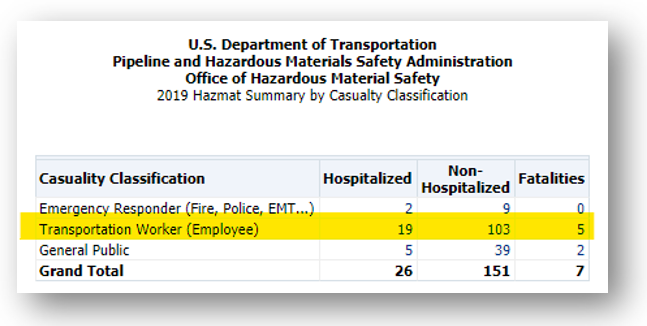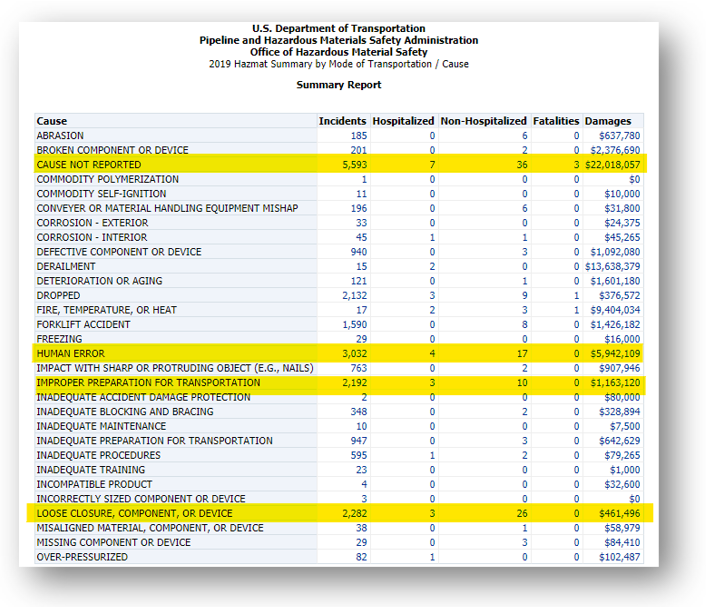
For workers in the Dangerous Goods supply chain, the first quarter of 2020 was extraordinary—for two reasons.
The first reason? That’s obvious. The COVID-19 pandemic triggered seismic shifts in what we ship, how much we ship and how we ship it, and the global supply chain met the challenge. Despite a steep drop in overall volume, the supply chain helped keep life relatively normal while almost every aspect of society endured unprecedented change.
The second reason won’t get much publicity, but it’s almost as important: It was an unusually safe quarter for hazmat transport in the United States. At a time when the importance of our supply chain is more in the spotlight than ever, that’s a trend worth reflecting on.
An unusually low number of injuries
As detailed here a couple of weeks ago, there were thousands of U.S. hazmat incidents in Q1 2020. As is typical, about 90% of them happened in highway transport, about half involved Class 3 Flammable Liquids, and spills were the most common type of incident.
One unusual—and most welcome—statistic was the low number of injuries. Out of 2,784 reported incidents, only five injuries were reported, and none of them required hospitalization.

Now, to be clear, five injuries is five too many. (For that matter, everyone in the industry would prefer to see zero incidents—but with literally millions of hazmat shipments moving every day, “zero” is never going to happen.) But these five minor injuries are an unusually low number compared with numbers from 2019.
And low injury numbers are great to see—especially these days, when many supply chain workers risk their health every time they go to work.
While their managers are sheltering at home, these men and women don protective gear to pack shipments, process warehouse orders and load trucks, potentially exposing themselves to disease to keep our vital supplies moving.
We’d like to think the Q1 numbers indicate a trend for the future, but if 2019 was any indication, we’re likely to see more—and more serious—injuries over the rest of 2020.
More injuries and deaths in 2019
This chart tells a sobering story:

Injuries were far more common in 2019 than in the first quarter of 2020—and more severe. Where only 5 injuries were reported in Q1 2020, 2019 saw 184. Of those, 26 required hospitalization. Seven were fatalities.

Most of those injuries (including five deaths) happened to transportation workers—the very people who currently risk their health every day they go to work during this pandemic. (Even worse, 44 injuries and two deaths were suffered by members of the general public.)
How were these workers injured? More importantly, could better Dangerous Goods compliance have prevented their injuries? Let’s take a closer look.
Would better compliance reduce or eliminate injuries?
Here’s a chart that breaks out how injuries occurred. We’ve highlighted four of the most prominent categories for incidents and injuries:

Of these four categories, the biggest one—“Cause Not Reported”—offers no information. But the other three suggest that insufficient hazmat training, products and processes may have played a role:
- Human Error: People make mistakes, but any EH&S professional will tell you that better-trained people make fewer of them.
- Improper Preparation for Transportation: These failures most likely involve hazmat packaging, an oft-misunderstood category and a major topic in many training regimens.
- Loose Closure, Component, or Device: Closure is such a critical topic, we’ve had Dangerous Goods Symposium sessions dedicated to writing better closure instructions.
These charts don’t conclusively prove that non-compliance caused injuries—only a deep examination of individual citations could do so. But they do suggest that many incidents and injuries correlate with conditions that better compliance would reduce or eliminate.
Or, to put it more simply: hazmat compliance keeps transportation workers safer.
Safety is the whole point
People often forget that safety is the whole point of all the Dangerous Goods rules and regulations we deal with every day. Our frontline workers won’t always have to worry about contracting COVID-19 every time they come to work, but the dangers posed by transporting hazardous materials will always be present.
If we truly want to show these workers how grateful we are for keeping our supply chains moving, let’s make Dangerous Goods compliance more important in their workplaces.
Make sure your shipments are safe and in complete compliance with a full line of solutions from Labelmaster—a full-service provider of goods and services for hazardous materials and Dangerous Goods professionals, shippers, transport operators and EH&S providers.


